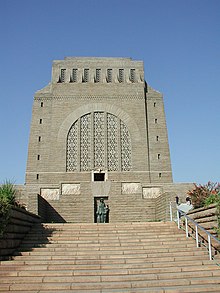Voortrekker monument
The Voortrekker Monument is a monument with stylistic elements of Art Deco that is located in the city of Pretoria in South Africa . The massive granite structure was built in honor of the Voortrekkers , who left the Cape Colony by the thousands between 1835 and 1854 to colonize other areas of what is now South Africa. The building was designed by the architect Gerard Moerdijk , who was born in the Waterberg district . The Völkerschlachtdenkmal in Leipzig is said to have served as a template for the design work.
history
The idea of erecting a memorial in honor of the Voortrekkers became public during President Paul Kruger's lifetime , but it was not until 1931 that an initiative was formed that wanted to realize this idea.
The construction of the monument began on July 13, 1937. Prior to the laying of the cornerstone traveled for symbolic reasons, some participants with traditional oxcart from Cape Town to Pretoria. After their arrival, a service was held on the monument hill. On December 16, 1938, the foundation stone was laid by three female descendants of the well-known Voortrekker guides Piet Retief , Andries Pretorius and Hendrik Potgieter .
The monument was inaugurated with a grand ceremony on December 16, 1949. The total cost of construction was over £ 360,000 , much of which was borne by the South African government. An amphitheater with a capacity of around 20,000 people was built in the northeast of the monument.
description
The building is 41 meters high and stands on a 40 × 40 meter base. Standing on a hill six kilometers from Pretoria, it towers above its surroundings and is visible from afar. Three of the four corners of the building are occupied by granite figures of Voortrekker guides Andries Pretorius, Hendrik Potgieter and Piet Retief, the fourth by a symbolic nameless Voortrekker guide. The 25 × 25 meter large Heroes' Hall can be accessed via external stairs. It is crowned by a 41 meter high dome. The floor is covered in marble slabs arranged in a wave shape. The history of the Great Trek is shown on 27 marble friezes in the hall. In the center of the hall is a circular opening that reveals the 34.5 × 34.5 meter so-called cenotaph hall below with a symbolic sarcophagus . On the annual anniversary of the Battle of the Blood River , at exactly 12:00 noon the sun shines through an opening in the cathedral of the Heroes' Hall on the sarcophagus: “Ons vir jou Suid-Afrika” ( Afrikaans ; German: “We for you, South Africa ").
The memorial is surrounded by a wall on which 64 stone ox carts are depicted. These symbolize a wagon castle that the Voortrekkers built with their wagons in the event of a defense.
Others
Fort Schanskop - one of the three preserved forts of the city of Pretoria - is located on the site of the Voortrekker monument (accessible via the common driveway) . Today there is a museum here.
literature
- Board of Directors of the Voortrekker Monument Pretoria (Ed.): The Voortrekker Monument, Pretoria. Official leader . (Translated by Johann Albert Ernst Leue), Pretoria 1961.
Web links
- Official website (English; Afrikaans)
Individual evidence
- ^ A b c Désirée Picton-Seymour, Janek Szymanowski: Historical Buildings in South Africa . Struikhof, Cape Town 1989, p. 162.
- ↑ DNB : bibliographic evidence .
Coordinates: 25 ° 46 ′ 35 ″ S , 28 ° 10 ′ 33 ″ E
